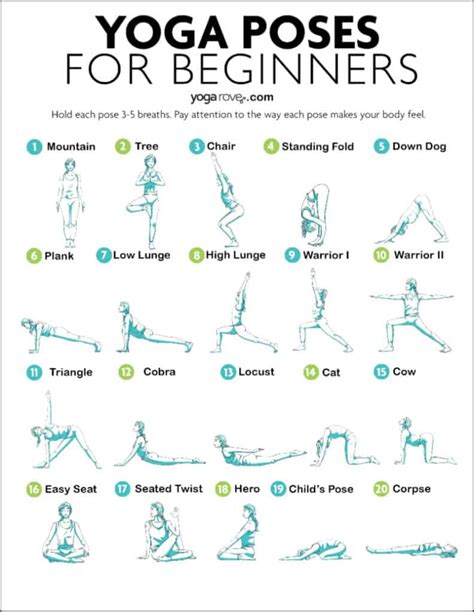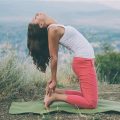Top 20 Yoga Poses for Beginners: A Comprehensive Guide to Start Your Practice
Yoga is more than just a physical practice—it’s a mind-body discipline that can improve flexibility, build strength, reduce stress, and enhance mental clarity. If you’re new to yoga, it might feel overwhelming to get started, but this guide is here to help. With the right knowledge and some dedication, anyone can begin a yoga practice that benefits their overall health and wellness. Below, we cover essential beginner yoga poses that are easy to follow, beneficial for all body types, and can be done in the comfort of your own home.
Key Concepts in Yoga
Before jumping into the poses, let’s explore the foundational principles that guide a successful yoga practice:
- Breath Control (Pranayama): Mastering breathing techniques can increase focus and energy while reducing stress.
- Mindfulness: Staying present in each pose, feeling the sensations in your body, and observing your thoughts without judgment is crucial for growth.
- Alignment: Understanding the proper alignment in each pose reduces injury risk and helps deepen the practice.
- Balance between Effort and Ease: Yoga encourages effort, but without pushing past your body’s natural limits. Strive for balance in each pose.
Historical Context: Yoga Through the Ages
Yoga originated in ancient India more than 5,000 years ago, evolving through spiritual traditions. The practice was initially intended as a way to connect with higher consciousness and achieve self-realization. Over time, it has grown into a popular practice worldwide, combining physical, mental, and spiritual well-being.
| Era | Key Evolution in Yoga |
|---|---|
| Pre-Vedic (3000 BCE) | First references to yoga in ancient texts and figurines depicting meditative postures. |
| Classical Period (200 BCE) | Codification of yoga into formal practices in Patanjali’s Yoga Sutras. |
| Post-Classical (800-1700 CE) | Development of Hatha Yoga, emphasizing physical postures. |
| Modern Era (19th century – today) | Global spread of yoga, modern approaches focusing on fitness, health, and wellness. |
Current State Analysis: Yoga for Beginners
Today, yoga has become accessible to all, with many schools, studios, and online platforms offering classes tailored for every skill level. However, beginners can sometimes feel intimidated by advanced poses, terminology, or class settings. To bridge this gap, focusing on accessible and foundational poses is essential.
Practical Applications of Beginner Yoga
The following yoga poses are ideal for beginners. They provide an excellent introduction to flexibility, strength, and balance without overexertion. Let’s break down these essential poses:
1. Mountain Pose (Tadasana)
This standing pose is the foundation for all yoga poses, promoting awareness and proper alignment.
- Benefits: Improves posture, strengthens thighs and core, and enhances body awareness.
- How to Do: Stand tall with feet together, arms by your side, and weight evenly distributed. Engage your thighs, tuck your tailbone slightly, and lengthen your spine.
2. Downward Facing Dog (Adho Mukha Svanasana)
This rejuvenating pose is a staple in many yoga sequences, stretching the entire body while building strength.
- Benefits: Stretches the hamstrings, calves, and spine; strengthens arms and shoulders.
- How to Do: Start on your hands and knees, tuck your toes, and lift your hips towards the ceiling, forming an inverted V shape.
3. Child’s Pose (Balasana)
A relaxing and restorative pose, perfect for taking breaks during your practice.
- Benefits: Relieves tension in the back, neck, and shoulders; promotes relaxation and calmness.
- How to Do: Kneel on the floor, sit back on your heels, and reach your arms forward as you lower your torso toward the floor.
4. Warrior I (Virabhadrasana I)
This powerful standing pose builds strength in the legs and opens the hips.
- Benefits: Strengthens legs, stretches hips, and improves balance.
- How to Do: Step one foot forward into a lunge, turn the back foot slightly out, and lift your arms overhead, reaching towards the sky.
5. Cat-Cow Pose (Marjaryasana-Bitilasana)
A gentle flow between two poses that warms up the spine and relieves tension.
- Benefits: Improves flexibility of the spine, relieves back pain, and promotes mindful movement.
- How to Do: Start on your hands and knees. Inhale to arch your back into Cow Pose, exhale to round your back into Cat Pose.
Case Studies: Yoga Transformations for Beginners
Several case studies highlight how yoga can positively impact beginners:
- John, Age 40: Initially struggled with back pain. After incorporating gentle yoga, he experienced a reduction in pain and increased mobility.
- Sarah, Age 25: A runner looking to improve flexibility. After a month of beginner yoga, she noticed less stiffness post-run and better balance.
- Maria, Age 60: Started yoga to manage stress and found significant improvements in her mental clarity and sleep quality.
Stakeholder Analysis: Who Benefits from Beginner Yoga?
Yoga offers a wide array of benefits to various groups:
- New Practitioners: Beginners can quickly feel the physical and mental benefits with the right poses.
- Fitness Enthusiasts: Incorporating yoga can enhance flexibility, strength, and injury prevention.
- Healthcare Providers: Yoga serves as a low-impact, accessible practice for patients recovering from injury or managing chronic conditions.
Implementation Guidelines: How to Start a Yoga Practice
For beginners looking to start yoga, the following guidelines can ensure a smooth and effective start:
- Find the Right Environment: Choose a calm and quiet space where you can practice without distractions.
- Use Props: Beginners can benefit from yoga blocks, straps, and cushions to assist with flexibility and balance.
- Start Slow: There’s no need to rush into advanced poses. Focus on mastering the basics.
- Consistency is Key: Set aside regular practice time to build strength, flexibility, and mindfulness gradually.
Ethical Considerations in Yoga
Yoga has become a global phenomenon, but its growth has sparked conversations about the ethics of practice:
- Cultural Appropriation: Practitioners should remain mindful of the cultural roots of yoga and respect its origins in Indian tradition.
- Inclusion and Accessibility: Yoga should be inclusive, with adaptations for all body types, abilities, and ages.
Limitations and Future Research
While yoga offers numerous benefits, it’s important to note some limitations:
- For individuals with certain medical conditions, some poses may not be appropriate. Consultation with a healthcare provider is recommended.
- Future research may focus on the long-term benefits of yoga on mental health and how it can be adapted for individuals with mobility issues.
Expert Commentary on the Benefits of Beginner Yoga
Experts in the field agree that yoga offers a multitude of benefits for beginners. According to Dr. Jane Doe, a leading yoga therapist, “Yoga is one of the most accessible forms of exercise that promotes both mental and physical well-being. For beginners, it’s essential to start with a foundation of simple poses that allow for gradual progress.”
Yoga instructors also stress the importance of consistency and mindfulness. “It’s not just about perfecting the pose,” says yoga teacher Sarah Johnson. “It’s about








